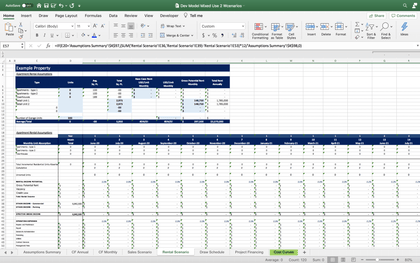10-Year Joint Venture Excel Real Estate Model with Refi Logic
10-Year Joint Venture Excel Real Estate Model with Refi Logic
Available:
In Stock
$70.00
Latest update: Includes up to 4 properties to be analyzed on the same timeline.
Users will be able to implement a wide range of financial strategies when using this tool.
This joint venture real estate model is designed so you manually enter the % of cash flow split between the investor and sponsor. This tends to be better for certain deals. In general, the revenue is based on rent roll inputs and grows at a certain rate. There is ancillary income slots as well.
For expenses you will determine the current expenses, starting expenses in year 1 if different, and then an annual growth rate per year.
The style of this model makes it really easy to adjust assumption by year for key variables.
The pro forma rolls everything up and splits all the cash in a series of summaries that include net income from operations, cash flow from refinance if applicable, cash flow from exit if applicable, and then the final cash splits for the investor pool and sponsor pool.
The refinance logic is important if you think you will do a single loan at the start and then work a higher LTV (loan to value) proceeds for a second loan that pays off the first and allows some cash to be split between the investor and sponsor. This can raise the IRR for both parties. You can choose to avoid a refinance.
At exit you can determine the exit cap rate and based on those proceeds the model automatically allocates that cash to any current debt and then distributes accordingly.
On the refi, you can determine a new rate for that. For the initial loan, you can choose an amount of years that it is interest only, likely to happen if you pay interest only for the first few years and then refinance at some point.
The exit year and refi year are 100% dynamic from year 1 to 10 and you can adjust them independently or have one or both not applied at all.
One of the important features is showing a split to an investor based on them investing a certain amount. This is important if there will be multiple investors and they want to see what their cash flows look like if they go in for some of the total investor funds required.
Other key summaries include ROI to date and annualized ROI for the sponsor and investor as well as accumulated cash position. There is a visual tab that shows the cash flow per year of the investor pool and sponsor pool.
Be aware that I am not a financial advisor and this is not financial advice. Be sure to use the model with your own assumptions.
Users will be able to implement a wide range of financial strategies when using this tool.
This joint venture real estate model is designed so you manually enter the % of cash flow split between the investor and sponsor. This tends to be better for certain deals. In general, the revenue is based on rent roll inputs and grows at a certain rate. There is ancillary income slots as well.
For expenses you will determine the current expenses, starting expenses in year 1 if different, and then an annual growth rate per year.
The style of this model makes it really easy to adjust assumption by year for key variables.
The pro forma rolls everything up and splits all the cash in a series of summaries that include net income from operations, cash flow from refinance if applicable, cash flow from exit if applicable, and then the final cash splits for the investor pool and sponsor pool.
The refinance logic is important if you think you will do a single loan at the start and then work a higher LTV (loan to value) proceeds for a second loan that pays off the first and allows some cash to be split between the investor and sponsor. This can raise the IRR for both parties. You can choose to avoid a refinance.
At exit you can determine the exit cap rate and based on those proceeds the model automatically allocates that cash to any current debt and then distributes accordingly.
On the refi, you can determine a new rate for that. For the initial loan, you can choose an amount of years that it is interest only, likely to happen if you pay interest only for the first few years and then refinance at some point.
The exit year and refi year are 100% dynamic from year 1 to 10 and you can adjust them independently or have one or both not applied at all.
One of the important features is showing a split to an investor based on them investing a certain amount. This is important if there will be multiple investors and they want to see what their cash flows look like if they go in for some of the total investor funds required.
Other key summaries include ROI to date and annualized ROI for the sponsor and investor as well as accumulated cash position. There is a visual tab that shows the cash flow per year of the investor pool and sponsor pool.
Be aware that I am not a financial advisor and this is not financial advice. Be sure to use the model with your own assumptions.



































